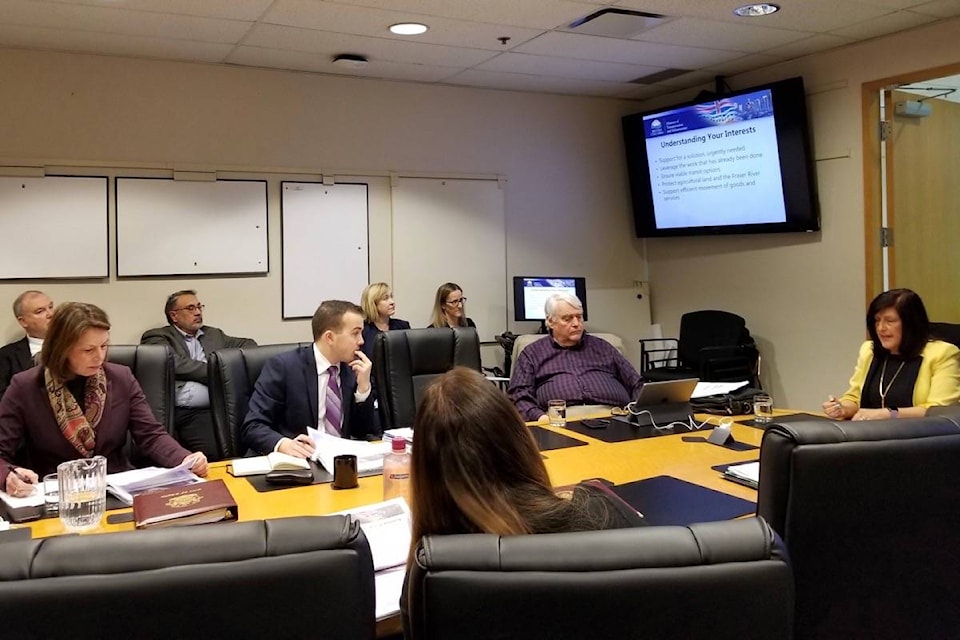Delta city council has informed the province that a replacement project for the George Massey tunnel has to come sooner rather than later.
Councillors got an update on the province’s plan for a new crossing between Delta and Richmond during a Monday (March 11) consultation session with Lina Halwani, the Ministry of Transportation and Infrastructure’s interim George Massey crossing project director. Council weighed in on the project, and gave Halwani their recommendations to take back to the ministry.
Halwani told council and city staffers that the province is “keenly aware” of the urgency and importance of having a decision on the new crossing soon. She said the ministry wants to settle on shared goals and objectives among local and regional governments, Indigenous groups and the public sometime this April, with a decision on what kind of crossing would best suit the region to come by November. A business case will follow in fall 2020.
“Concurrently, we’ll be working with Delta, Richmond and the Tsawwassen First Nation to identify interim improvements to relieve traffic congestion,” Halwani told council. “Our goal is to be tender-ready with these improvements by the fall of 2020.”
RELATED: Unity needed among mayors on Massey Tunnel replacement, Delta mayor says
Until then, the ministry will also work on immediate safety improvements to the aging tunnel, including better lighting, road resurfacing and drainage. As for when the region will have a new crossing, Halwani could not give an answer, only an optimistic estimate of 2025.
“Once the business case is completed in the fall [of 2020], we need to secure funding partners, then get into the design and then get to the construction,” Halwani said. “There is a process that needs to be followed to facilitate the design and the physical construction.”
Mayor George Harvie said completing the crossing by 2025 would be unrealistic if the province and stakeholders settle on an above-ground option that makes contact with the Fraser River. At that point, he said, the process will not only be delayed by a federal environmental assessment, but by opposition by the Tsawwassen and Musqueam First Nations.
“Their first priority, which they asked us to support, was protecting the salmon, protecting their heritage rights of fishing,” Harvie said.
“If [the project does] touch that river, it’s going to [require] a federal environmental assessment — we confirmed that back in Ottawa two weeks ago — and at the very end, it could possibly, more than very likely, be a no.”
If that happens, he said, completion could be pushed to 2030.
“That’s totally unacceptable for us.”
One option Harvie brought up with Halwani was a new deep-bore tunnel which would not touch the river, arguing that it could be a more time efficient solution as well.
“So I think your options have to look at which one will be the least [risky] from a environmental assessment point of view [and] on time,” Harvie said.
The mayor also suggested that if the project is starting anew, it should not use the current crossing’s name.
“We are not going to accept a refurbished tunnel that is 60 years old,” the mayor said, adding that some Deltans think the province is merely going to patch up the existing tunnel.
“From our engineering studies, we have learned there is a reason there are nets at the top of the tunnel as you exit or enter. It’s because it’s falling apart.”
Coun. Bruce McDonald did not fully agree with a new tunnel, citing a conversation he had with a guest at last Friday’s economic breakfast who said that if an earthquake strikes, the tunnel may have to be shut down.
“What would we do with the 80,000 plus vehicles a day that go through the tunnel?” McDonald said, asking for the ministry to conduct a study of such a scenario.
“The impact on this region if we ever had to shut it down would be absolutely devastating in every perspective. I think it’s a possibility.”
Coun. Lois Jackson said she still sees the need for a 10-lane bridge, with each side featuring three car lanes, a transit lane to be used ideally by a SkyTrain system, and an additional lane to handle future vehicle capacity.
“At this point in time, we have three lanes jammed in the morning, three lanes jammed at night, so really you’ve got to have those three lanes both ways,” Jackson told Halwani. “I still feel it is important that we stick with the 10 lanes, and that’s my reasoning.”
RELATED: 10-lane George Massey bridge too big, B.C. study says
sasha.lakic@northdeltareporter.com
Like us on Facebook and follow us on Twitter
